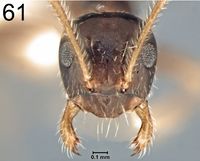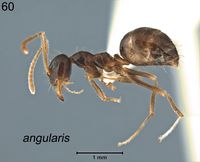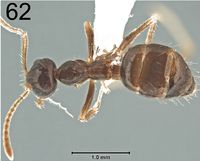Prenolepis angularis
| Prenolepis angularis | |
|---|---|

| |
| Scientific classification | |
| Kingdom: | Animalia |
| Phylum: | Arthropoda |
| Class: | Insecta |
| Order: | Hymenoptera |
| Family: | Formicidae |
| Subfamily: | Formicinae |
| Tribe: | Lasiini |
| Genus: | Prenolepis |
| Species: | P. angularis |
| Binomial name | |
| Prenolepis angularis Zhou, 2001 | |
Nothing is known about the biology of Prenolepis angularis.
Identification
Zhou (2001) - Resembles Prenolepis naoroji, but differs from the latter in clypeus without median carinae and not ridged; mesopleuron longitudinally striate; declivous face of propodeum steeply oblique, conjunction between basal face and declivous face angular.
Williams and LaPolla (2016) - Obtusely angled propodeum with flat dorsal and posterior faces; erect setae on scapes and legs; light blue cuticular iridescence.
This species and Prenolepis naoroji are the only Prenolepis to have a light blue cuticular iridescence. Prenolepis angularis can most easily be distinguished from P. naoroji by its obtusely angled propodeum, smaller compound eyes that do not surpass the lateral margins of the head in full-face view, and erect setae on the scapes. Prenolepis angularis is also much less hirsute than P. naoroji and its macrosetae are shorter in length.
Keys including this Species
Distribution
Distribution based on Regional Taxon Lists
Palaearctic Region: China (type locality).
Distribution based on AntMaps
Distribution based on AntWeb specimens
Check data from AntWeb
Countries Occupied
| Number of countries occupied by this species based on AntWiki Regional Taxon Lists. In general, fewer countries occupied indicates a narrower range, while more countries indicates a more widespread species. |

|
Estimated Abundance
| Relative abundance based on number of AntMaps records per species (this species within the purple bar). Fewer records (to the left) indicates a less abundant/encountered species while more records (to the right) indicates more abundant/encountered species. |

|
Biology
Castes
Nomenclature
The following information is derived from Barry Bolton's Online Catalogue of the Ants of the World.
- angularis. Prenolepis angularis Zhou, 2001b: 173, 242, fig. 344 (w.) CHINA.
Unless otherwise noted the text for the remainder of this section is reported from the publication that includes the original description.
Description
Worker
Holotype: TL 3.0, HL 0.79, HW 0.75, CI 94, SL 0.98, SI 130, PW 0.44, AL 1.00, ED 0.20.
Head oval, slightly longer than broad, occipital border slightly convex. Masticatory margin of mandibles with 6 teeth, apical, 4th, basal teeth longer. Middle clypeus convex but not carinate; anterior border sinuate. About 1/2 length of antennal scapes extending beyond the occipital border. Eyes slightly convex, situated behind the midlength of the sides of head. Promesonotum formed a single convexity, distinctly longer than the propodeal convexity; mesothorax constrict; basal face of propodeum flat, declivity steeply oblique, conjunction between them distinctly angular. Petiolar node high, not hung over by gaster, dorsal margin straight. Gaster shortly wide, dorsum convex, base of first gastral segment declined forward, lower than the petiolar node.
Smooth and shining. Mesopleuron with longitudinal striations. Propodeum sparsely feebly punctate.
Erect hairs yellow, relatively dense. Pubescence sparse.
Color yellowish brown. Antennae and legs slightly lighter. Gaster contaminated brown.
Paratypes 29: TL 2.9~3.1, HL 0.75~0.79, HW 0.72~0.75, CI 94~96, SL 0.93~0.98, SI 129~130, PW 0.42~0.47, AL 0.91~1.06, ED 0.19~0.20.
Williams and LaPolla (2016) - Worker. Measurements (n=4): CMC: 9–10; EL: 0.20–0.24; EW: 0.18–0.20; HL: 0.72–0.83; HLA: 0.38–0.41; HLP: 0.25–0.27; HW: 0.69–0.76; IOD: 0.48–0.50; LF1: 0.17–0.19; LF2: 0.10–0.11; LHT: 0.92– 0.95; MMC: 1–2; MTW: 0.40–0.44; MW: 0.24–0.29; PDH: 0.28–0.32; PMC: 5–8; PrCL: 0.45–0.47; PrCW: 0.24– 0.28; PrFL: 0.71–0.78; PrFW: 0.16–0.19; PTH: 0.31–0.35; PTL: 0.33–0.36; PTW: 0.23–0.26; PW: 0.45–0.49; SL: 0.92–1.03; TL: 2.80–3.17; WF1: 0.07–0.08; WF2: 0.06–0.07; WL: 0.98–1.12; BLI: 139–143; CI: 91–98; EPI: 145–153; FLI: 169–174; HTI: 126–134; PetHI: 109–112; PetWI: 70–73; PrCI: 55–57; PrFI: 23–24; REL: 27–30; REL2: 29–31; REL3: 43–47; SI: 131–136.
Medium to dark brown, with cuticle having a light blue iridescence; cuticle of head and pronotum smooth and shiny; cuticle of mesopleuron, propodeum, and gaster lightly reticulate; abundant erect setae on scapes and legs; abundant long, erect macrosetae on head, mesosoma, and gaster; head about as broad as long and square in shape with indistinct posterolateral corners and a weakly convex posterior margin; compound eyes moderately large and convex, but do not surpass the lateral margins of the head in full-face view; torulae overlap with the posterior border of the clypeus; anterior border of clypeus with a pair of prominent anterolateral lobes; mandibles with 6 teeth on the masticatory margin; ectal surface of mandibles with light longitudinal striations; in profile view, propodeum is obtusely angled with a flat dorsal face; dorsal apex of petiole scale is sharply angled and forward-inclined
Type Material
Holotype worker, Mao Er Shan Natural Reserve, Guangxi, 10.VII.1994, Shanyi Zhou leg. Paratypes: 9 workers, data as holotype. 20 workers, location as holotype, 1.VII.1996, Shanyi Zhou leg.
Williams and LaPolla (2016) - Holotype worker, China: Guangxi Province, Mao’er Mt. Nature Reserve, 25°44.21’N 110°19.25’E, 934.5m, 10.vii.1994 (Guangxi Normal University) [examined].
References
- Chen, Z., Zhou, S. 2018. A review of the ant genus Prenolepis (Hymenoptera: Formicidae) in China, with descriptions of four new species. Zoological Systematics 43:58-65 (DOI 10.11865/zs.201806).
- Liu, C., Fischer, G., Hita Garcia, F., Yamane, S., Liu, Q., Peng, Y.Q., Economo, E.P., Guénard, B., Pierce, N.E. 2020. Ants of the Hengduan Mountains: a new altitudinal survey and updated checklist for Yunnan Province highlight an understudied insect biodiversity hotspot. ZooKeys 978, 1–171 (doi:10.3897/zookeys.978.55767).
- Williams, J. L. and J. S. LaPolla. 2016. Taxonomic revision and phylogeny of the ant genus Prenolepis (Hymenoptera: Formicidae). Zootxa 4200(2): 201–258 (doi:10.11646/zootaxa.4200.2.1).
- Zhou, S. 2001. Ants of Guangxi. Guilin, China: Guangxi Normal University Press, 255 pp.: 255pp (page 173, 242, fig. 344 worker described)
References based on Global Ant Biodiversity Informatics
- Guénard B., and R. R. Dunn. 2012. A checklist of the ants of China. Zootaxa 3558: 1-77.
- Ran H., and S. Y. Zhou. 2013. Checklist of Chinese Ants: Formicomorph Subfamilies ( Hymenoptera: Formicidae) (III). Journal of Guangxi Normal University : Natural Science Edition 31(1): 104-111.
- Zhou S.-Y. 2001. Ants of Guangxi. Guangxi Normal University Press, Guilin, China, Guilin, China. 255 pp.


